This morning the U.S. Census Bureau released its latest data on poverty, income, and health insurance coverage. The results showed that incomes increased and poverty declined for a third consecutive year.
Highlights of the Census Report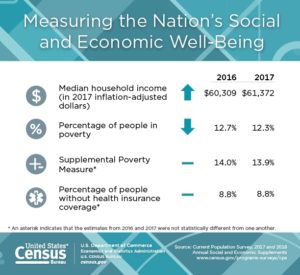
- Income: Real median household income increased by 1.8 percent between 2016 and 2017
- Median household income in the United States in 2017 was $61,372, up from the 2016 median income of $60,309.
- Poverty: The nation’s official poverty rate in 2017 was 12.3 percent, down 0.4 percentage points from 12.7 percent in 2016.
- In 2017, 39.7 million people lived in poverty. The number of people in poverty in 2017 was not statistically different from the number in poverty in 2016 (40.6 million).
- Since 2014, the poverty rate has fallen 2.5 percentage points, from 14.8 percent to 12.3 percent.
- Health Insurance: The percentage of people without health insurance coverage for the entire 2017 calendar year was 8.8 percent, or 28.5 million, not statistically different from 2016.
- Between 2016 and 2017, the number of people with health insurance coverage increased by 2.3 million, up to 294.6 million.
- Supplemental Poverty Measure: The Supplemental Poverty Measure (SPM) takes into account various programs, tax credits, and expenses in a more nuanced view of the poverty rate.
- The SPM rate for 2017 was 1.6 percentage points higher than the official poverty rate of 12.3 percent.
- Social Security transfers and refundable tax credits had the largest impacts, preventing 27.0 million and 8.3 million individuals, respectively, from falling into poverty.
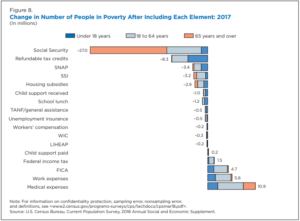
Impact of the CSBG Network on Poverty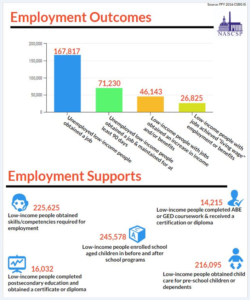
The CSBG network tackles the complex issues of poverty by addressing the needs of individuals, families and communities within domains such as employment, education, health, housing, and more. Using programs and services tailored to local needs, Community Action Agencies (CAAs) develop human capacity and decrease dependency. The CSBG Network is working daily to help families to become stable and achieve economic security. A few outcomes from Federal Fiscal year (FFY) 2016 include:
- 5.8 million participants with low-incomes obtained supports which reduced or eliminated barriers to employment, acquired a job, obtained an increase in employment income, or achieved “living wage” employment and benefits.
- 4.2 million infants, children, youth, parents and other adults participated in developmental or enrichment programs facilitated by the CSBG Network and achieved program goals.
- 3.2 million vulnerable individuals with low-incomes received services and secured or maintained an independent living situation as a result.
- 3.1 million community resources or opportunities (e.g. transportation programs, youth programs, health care services, affordable housing, and child care programs) were improved or expanded for people with low-incomes as a result of CSBG Network projects or initiatives.
- 1.2 million community members and people with low incomes mobilized to engage in activities that support and promote their own well-being and that of their community as a direct result of CSBG Network initiatives through maximum feasible participation.
CSBG On the Ground
CSBG moves the needle on our nation’s poverty rate through a network of over 1,000 CAAs serving 99% of U.S. counties. Below are a few case studies from across the country demonstrating how CSBG works to help people with low incomes create change for themselves and create communities that are healthy and offer economic opportunity:
 Comprehensive Economic Security in North Carolina: Community Action Opportunities (CAO) in North Carolina runs a program called Life Works. Life Works is a comprehensive economic security program using a holistic case management model to promote economic independence. Life coaches assist with creating action plans, job counseling, supportive coaching, budgeting, credit repair, etc. In FY 2017 and FY 2018 the Life Works program served 137 families:
Comprehensive Economic Security in North Carolina: Community Action Opportunities (CAO) in North Carolina runs a program called Life Works. Life Works is a comprehensive economic security program using a holistic case management model to promote economic independence. Life coaches assist with creating action plans, job counseling, supportive coaching, budgeting, credit repair, etc. In FY 2017 and FY 2018 the Life Works program served 137 families:
- 39 families rose above the federal poverty guidelines
- 40 families gained employment
- 44 gained better employment
- 38 completed education/ training
- 21 obtained standard housing
- 18 obtained medical benefits
 Economic Mobility in Texas: The Texas Department of Housing and Community Affairs (TDHCA) administers CSBG for the State and oversees a network of 41 CAAs. Each year, TDHCA collects indicators reporting movement out of poverty. In FY 2017, Texas CAAs reported:
Economic Mobility in Texas: The Texas Department of Housing and Community Affairs (TDHCA) administers CSBG for the State and oversees a network of 41 CAAs. Each year, TDHCA collects indicators reporting movement out of poverty. In FY 2017, Texas CAAs reported:
- 5,764 unduplicated people working towards transitioning out of poverty.
- 1,139 unduplicated people (including all household members) who achieve a household income of 125% of the poverty level, or greater, through agency assistance and have been tracked for at least 90 days. These clients must have been tracked for 90 days and documentation kept on services provided, follow-up conducted, and income documented.
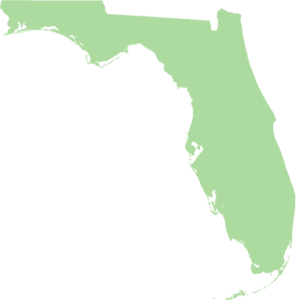 Community Level Initiative in Florida: Pinellas Opportunity Council, Inc. is the Community Action Agency serving St. Petersburg, Florida. Pinellas is a founding member of the 2020 Plan Task Force, a Collective Impact group started in 2015 whose goal is to reduce poverty in South St. Petersburg by 30% by the year 2020. The 2020 Plan formula for accelerating poverty reduction is threefold:
Community Level Initiative in Florida: Pinellas Opportunity Council, Inc. is the Community Action Agency serving St. Petersburg, Florida. Pinellas is a founding member of the 2020 Plan Task Force, a Collective Impact group started in 2015 whose goal is to reduce poverty in South St. Petersburg by 30% by the year 2020. The 2020 Plan formula for accelerating poverty reduction is threefold:
- Reduce poverty by increasing incomes: Because poverty is defined by income, 2020’s focus is to increase incomes through full-time, part-time and self-employment.
- Target parents, especially dads: 2020 targets employment primarily to parents-in-poverty because for every parent who exits poverty, an average 1.4 children do as well. The goal is for 70% of parents served (2,450) to remain on track by the 2020 Census.
- Strengthen families: In addition to job training, placement, and retention support, 2020 also utilizes wrap-around family services to help parents become active in their children’s success.
The 2020 Plan recently underwent an impact study to assess its progress towards completing its goals.
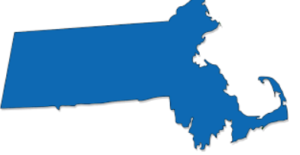 Bundled Services in Massachusetts: Action for Boston Community Development (ABCD) serves the Boston area and runs a program called Generations Advancing Together through Education (GATE). GATE engages ABCD’s Child Care Choices of Boston in partnership with three local training providers to bundle and streamline access to child care and job training vouchers. Participants select a training program from either the financial services, healthcare, or computer technology fields and work with ABCD staff to identify and select child care options. ABCD helps participants navigate the job search and placement process and provides wraparound case management services to connect families with resources that might be needed (e.g., fuel assistance, housing, food pantry). In 2017 outcomes from GATE’s first year of bundled services include:
Bundled Services in Massachusetts: Action for Boston Community Development (ABCD) serves the Boston area and runs a program called Generations Advancing Together through Education (GATE). GATE engages ABCD’s Child Care Choices of Boston in partnership with three local training providers to bundle and streamline access to child care and job training vouchers. Participants select a training program from either the financial services, healthcare, or computer technology fields and work with ABCD staff to identify and select child care options. ABCD helps participants navigate the job search and placement process and provides wraparound case management services to connect families with resources that might be needed (e.g., fuel assistance, housing, food pantry). In 2017 outcomes from GATE’s first year of bundled services include:
- 49 individuals enrolled in a GATE job training program
- 47 child care vouchers were issued
- 25 individuals completed a GATE job training program
- 18 participants continued their GATE enrollment into FY2018
- 60% of GATE participants (15/25) obtained a job with an hourly wage that ranged from $12.25 to $40.63
The Fight Continues
The new Census report shows that significant gains in the fight against poverty have been made, and that antipoverty programs are indeed decreasing poverty rates. However, the most effective anti-poverty programs face threats of funding cuts and full-scale elimination. In FY16 alone, the CSBG network served 15.8 million people, of the 4.5 million people reporting their income levels, 70% were at or below 100% of the federal poverty level. This demonstrates that significant need still exists.
The CSBG network continues to work with the poorest in our communities to be a support as they work to move beyond poverty towards economic security. The Census report shines a light on the potential gains to be made from an even stronger federal investment in the poverty solutions of CSBG. From bundled services, to two-generation approaches, to collective impact – the CSBG network is at the forefront of innovation in the fight against poverty. Community Action Agencies stand ready to implement new pilot programs, test promising practices, and further reduce poverty in America.
For more resources and analysis of the new poverty data, check out the following sources:
– U.S. Census Bureau
– Center on Budget and Policy Priorities
– Spotlight on Poverty and Opportunity





